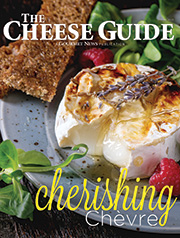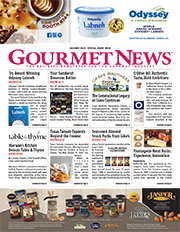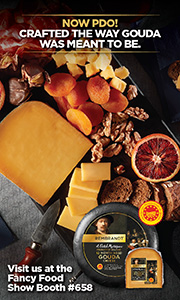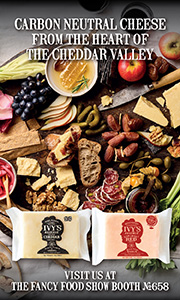
Featured Stories
Seal Certifies Coolness Under Pressure
By Lorrie Baumann
 Manufacturers of products pasteurized with High Pressure Processing, HPP, instead of heat are adopting a High Pressure Certified Seal to assure consumers that they’re buying products that offer more than a fresh appearance – they’re also safe to consume. The first products bearing the High Pressure Certified Seal are fruit juices; with other certifications rolling out into the consumer market this year.
Manufacturers of products pasteurized with High Pressure Processing, HPP, instead of heat are adopting a High Pressure Certified Seal to assure consumers that they’re buying products that offer more than a fresh appearance – they’re also safe to consume. The first products bearing the High Pressure Certified Seal are fruit juices; with other certifications rolling out into the consumer market this year.
 “It’s actually in the marketplace now. You’ll see it on a lot of the Evolution Fresh products now throughout the nation. … It’s going to establish a standard to which a lot of products are going to be held,” said Jeff Williams, Chairman of the Cold Pressure Council, which is the organization behind the High Pressure Certified Seal and General Manager of JBT/Avure Technologies, which manufactures HPP machines that are used in HPP processing.
“It’s actually in the marketplace now. You’ll see it on a lot of the Evolution Fresh products now throughout the nation. … It’s going to establish a standard to which a lot of products are going to be held,” said Jeff Williams, Chairman of the Cold Pressure Council, which is the organization behind the High Pressure Certified Seal and General Manager of JBT/Avure Technologies, which manufactures HPP machines that are used in HPP processing.
HPP is a food pasteurization technique recognized by the federal Food and Drug Administration and used worldwide. Originally invented in France in 1895, it’s been in commercial use for almost 30 years. The process uses ultra-high pressure purified water to destroy bacteria so food stays fresher longer. Foods like meat, fruits, vegetables and juices are subjected to 87,000 pounds of pressure per square inch, which kills Listeria, E. coli and Salmonella bacteria without destroying the foods’ natural vitamin and mineral content. Foods processed with HPP have better taste, texture and nutritional value than foods processed with traditional high-heat pasteurization.
The High Pressure Certified Seal on a product’s packaging means that the product was processed in compliance with guidelines established by the Cold Pressure Council’s founding members to ensure that the equipment was used properly– that no food safety short cuts were taken along the way. “It’s a quality statement in terms of how the product was manufactured,” Williams said. “One of the key qualifiers is that they’ve been independently audited and that they are following the guidelines.”
The guidelines are intended to protect both consumers and the high pressure technology itself from the effects of a breach in food safety, according to Williams. “It’s like anything — if you’re not following the rules, bad things can happen,” he said. “We hate even thinking about those kinds of things. We want to make sure that our people aren’t misusing the technology; that there’s proper use of high pressure processing, so food safety stays intact; that the proper parameters and settings are being used – it does all go back to food safety.”
Juices bearing the seal are the first products to reach grocers because theirs was the first set of guidelines to be developed, but guidelines for sauces and salad dressings are in the works, and there are other sets of guidelines in development for the range of products suitable for the technique. In general, those are products that have a high water content, are acidic and have a cold chain of distribution. Brands are lined up and waiting for the release of their guidelines, so grocers and consumers can expect that they’ll start seeing the High Pressure Certified Seal on more products this year, according to Williams.
Manufacturers have been eager to adopt the technology because the HPP process brings compelling benefits, including better taste, texture and nutritional value than foods processed with traditional high-heat pasteurization as, well as, extension of the shelf life for products. For instance, guacamole that’s made and stored at home can last about one or two days, but guacamole that’s been pasteurized through High Pressure Processing gets a 40-day shelf life without the addition of any preservatives, resulting in a cleaner label for the consumer.
Along with the seal’s roll-out, the Cold Pressure Council will be engaging in a social media campaign to educate consumers about the benefits of the process. The Cold Pressure Council is also hosting an annual conference in June to continue to educate the industry itself about the technology and its benefits as well as the marketing value of the new High Pressure Certified Seal.
Lifetime Achievement Honorees Named by Specialty Food Association
Paul Prudhomme, the late celebrity chef, and distributor Seymour Binstein will be recognized by the Specialty Food Association with Lifetime Achievement Awards, which recognize those who have grown the specialty foods industry and inspired others to do the same.
Seymour Binstein founded European Imports as a cheese importer in 1978, and then parlayed his tremendous success into a full gourmet distribution business. Binstein pioneered the sales of specialty foods in foodservice distribution. His love of new and unique foods enhanced the whole specialty food industry. Customers, suppliers and employees were all treated as family creating loyalties still existing today.
Paul Prudhomme of Magic Seasoning Blends is widely credited with popularizing Creole and Cajun cuisine – the distinctive flavors of his native Louisiana – into the international spotlight. In 1979, K-Paul’s Louisiana Kitchen opened in New Orleans. Four years later, Prudhomme created his own line of all-natural herbs and spices, and smoked meats. The chef passed away in 2015 and the award will be presented to his family.
The 2018 inductees were chosen by the SFA’s Hall of Fame/Lifetime Achievement Committee and will be honored at the Summer Fancy Food Show in New York the evening of July 1, 2018. Registration for the Fancy Food Show is at fancyfoodshows.com.
A Condiment that Comes with Community
By Lorrie Baumann
To make it in the U.S., you need either financial capital or intellectual capital, according to Gerard Bozoghlian, whose family emigrated from Argentina to the U.S. in 1991; “Mom’s rich intellectual capital is an archive of Argentine culinary methods and traditions.”
Those recipes included authentic recipes for Argentinian chimichurri sauces that his mother, Azniv, had developed while she was cooking for the Bozoghlian family and friends. Azniv, herself of Greek descent and who had grown up in a Greek neighborhood in Argentina; the food she’d been served at home was what she knew. After she married Bozoghlian’s father, Carlos, and settled into housekeeping, she felt the need to expand her culinary repertoire, so she took herself off to culinary school. “The running joke in the family is that Dad told Mom that he could eat dolmades and moussaka a couple of times a week, but that he wanted his dose milanesa, lasagna and empanadas as often as possible,” Bozoghlian says. “She really has an ardent passion for food, to become one with the essence, the roots and eventual influences of Argentine culinary traditions. Every family vacation was grounded and planned around culinary excursions. Visiting the Rosa Mosqueta harvest in Bariloche or the tomato harvest in Rio Negro. As a family, much of our time spent bonding revolved around the discovery of ingredients and the overall appreciation of food and wine.”
After the family moved to the U.S. when Gerard, the youngest of three brothers, was 15, the older boys went off to college, one to UCLA and one in Pasadena, and the whole family focused on finding a sense of community for themselves in West Hollywood. “In Argentina, everyone was home for dinner at 9 p.m. In the States in the ‘90s, honoring a nightly family dinner schedule was a challenge. There was an increasing feeling of separation,” Bozoghlian says. “In Buenos Aires, extended family gatherings were the norm on the weekends. Here, we just had the five of us, and the Los Angeles work/university travel times and distances were spreading us thin. Maintaining our strongly bonded family unit meant everything.”
The family worked hard to turn Azniv’s recipe collection into the basis for a menu for an authentic Argentinian steakhouse that began attracting other Argentine emigres. “Slowly we developed the community we dreamed to have,” Bozoghlian says. Today we’re blessed to have guests who have been dining with us for 22 years. Families that discovered us when their children were toddlers are now hosting their college graduation celebrations at Carlitos Gardel.”
Eventually, Max Bozoghlian, the oldest of the three brothers, became one of an early wave of professional sommeliers in Los Angeles, Rodrigo went off to law school, and Gerard, at 21, graduated from his apprenticeship under his mother to become the restaurant’s general manager. A couple of years later, Azniv decided that she’d laid enough of a foundation for the restaurant’s kitchen that she could take a step back from working a regular shift at the restaurant — although she is still very much in charge of the desserts there.
Somehow, Gerard decided that he wasn’t busy enough just operating the restaurant, and he began working on the development of recipes for the sauces so they could be preserved as shelf-stable products while still maintaining their authentic character. He found mentors in Freddy Carbajal, Founder and CEO of Dotta Foods International, Inc., and Eliot Swartz, co-Founder and co-Chair of Two Chefs on a Roll, Inc.“Freddy really took me under his wing. Introduced me to some of the top food scientists,” Bozoghlian says. “He wanted to see me succeed. Even with his and others’ help, it took five years to formulate the first product that’s shelf-stable, authentic in terms of composition: staying true to authentic ingredients found in chimichurri; and also authentic in terms of consistency. We don’t produce an emulsified paste. We produce a hand-crafted, free-flowing sauce, and it goes into the jar that way. There’s never a time when the full integrity of the sauce is not honored.”
“Argentines respond to Gardel’s Chimichurri because they recognize it as what they’ve always known chimichurri to be,” he continues. “That was my goal — to stay true and honor our traditions.”
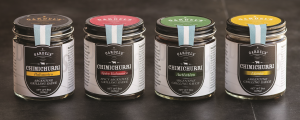 Some of that story is now on the label of each of Gardel’s Fine Foods’ chimichurri sauces. All made with 100 percent extra virgin olive oil and no added sugar, they are Chimichurri Balsamico, Chimichurri Spicy Balsamico, Chimichurri Autentico and Chimichurri Lime. Each jar holds 8 ounces of sauce and retails for $8.99 to $11.99. Nationwide distribution is available. For more information, visit www.chimichurrisauce.com.
Some of that story is now on the label of each of Gardel’s Fine Foods’ chimichurri sauces. All made with 100 percent extra virgin olive oil and no added sugar, they are Chimichurri Balsamico, Chimichurri Spicy Balsamico, Chimichurri Autentico and Chimichurri Lime. Each jar holds 8 ounces of sauce and retails for $8.99 to $11.99. Nationwide distribution is available. For more information, visit www.chimichurrisauce.com.
